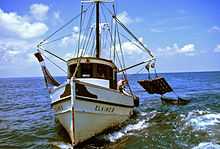Electric pulse fishing

The pulse trawl: electrodes in the two direction of the gear cause an electric field above the seabed, which stimulate the flatfish so that come up and end up in the net
Electric pulse fishing is a fishing technique sometimes used in trawl fisheries which produces a limited electric field above the seabed to catch fish.[1] The pulse trawl gear consists of a number of electrodes, attached to the gear in the tow direction, that emit short electric pulses. The electrodes replace the tickler chains that are used in traditional beam trawl fishery. The pulse trawl fishery is mainly aimed at flatfish like sole, with by-catch plaice. In addition, the pulse trawl gear is applied in shrimp fisheries on a limited scale. Technically, the use of electricity to catch fish is prohibited in European waters. However, the European Union is able to provides exemptions to this rule since 2007. These exemptions are now mainly used by Dutch and British[2] trawlers in the North Sea.
Electric pulse fishing should not be confused with pulse fishing, which is a fisheries management technique for preventing fish stocks from being overfished by periodically permitting a cycle of fishing followed by a fallow period which allows stocks to reconstitute.[3]
See also
References
External links

